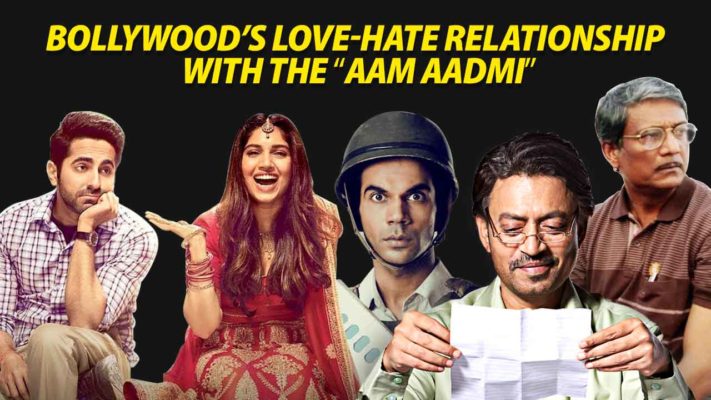
If Films Are To Be Judged On Absolute Terms, There’s A Work Of Art For Every Connoisseur
Do Bigha Zamin, Rang Birangi and Paar, these classics are considered paradigm in portraying the life of bedraggled protagonists- victims of circumstances. These films are not simply emblematic of their times, but also a hiatus from the otherwise saccharine portrayal of “class” in Bollywood. Amol Palekar, Utpal Dutt and Naseeruddin Shah came to embody the prototypical dishevelled middle-class “aam aadmi“, our new everyman.
The 90s was certainly a death knell for this lot of aam aadmi, who shared space on screen either as stock characters, dramatic foils, token characters, marginalized on screen and hastily sketched for the sake of it. The unadorned simplicity of yesteryear was lost in the quagmire of time. Anything a bit homespun or middle class on screen was considered a risky force de resistance, not the usual Bollywood staple.
The cinematic representation of “common-man” made a fresh comeback with Dil Chahta Hain in 2001- an affair with heartbreak and domestic disharmony wrapped up in linen silk. ZNMD or Dil Dhadakne Do were no different, the characters had money and privilege. Priyanka Chopra’s character Ayesha Mehra from Dil Dhadakne Do can fancy controlling her father’s business but Sulochana from Tumhari Sulu would always be grounded in her class realities- “loan toh milegi na?”
There is an irresistible enigma of stardom, exuding from the simplicity of these “aam” characters. It is precisely why these films have been able to dismantle the glass ceiling in an industry where a Sairat automatically turns into Dhadak.
Vikramaditya Motwane stated an interesting aspect in an interview to Firstpost, commenting on the lack of artistic liberty in Bollywood-
“…less-talented writers are entrusted with the script, which is a film’s backbone. Also, the lack of recognition for writers and inadequate payment rates create a system in which writers work with little creative satisfaction.”
The Simple Formula Of Aam Aadmi-ness
The prototypical aam aadmi, who was firmly rooted in his socio-political limitations, was pitted against the world appeared in intervals like Jane Bhi Do Yaaro, Bhuvan Shome, and Hyderabad Blues. Bollywood was recuperating from the cocktail of Govinda-Kader Khan entertainment, breezy song sequences, and threadbare storyline. Films like Hyderabad Blues are like a needle in a haystack.
When, The Lunchbox, Dum Laga Ke Haisha, Shubh Mangal Saavdhan and Mukti Bhawan came gushing into the theatre, it once again reminded us of Bollywood’s timeless tryst with aam aadmi. Looking back, the formula of crisp storytelling, observational humour and a convincing face has apparently consolidated the gap between crass entertainment and fierce sermonizing.
The stories become a one-pot dish serving slices of life in a plaintive manner; these films neither boast of possessing physical grandeur of a superhero film nor its moral ambitions. It must have taken a considerable leap of faith for the directors to work with debutantes, novices, and non-actors, which is a welcome change since nepotism has spread like an epidemic in Bollywood!
Juicy Middle-Class Sentimentality In Bollywood
Quirky characters like Newton, Raajiv (Mukti Bhawan), Saajan Fernandes (Lunchbox), and Mudit Sharma (Shubh Mangal Saavdhan) are all created with a humanistic approach. They queued up one after another, and before you knew it, the vehement advent of semi-urban aam aadmi had found its inroad into commercial cinema.
A typical aam aadmi character is so firmly enmeshed into their middle-class reality, that it will readily put to shame the 1990s Suniel Shetty. The alluring visual framework allows the audience to derive a voyeuristic pleasure as if they were sneaking into the characters’ lives. In Mukti Bhawan, Shubhashish Bhutiani depends on avant-gardism to portray something as bizarre as a hotel in Varanasi where people go to die.
How Easy Is It To Make A Business Out Of The Tragedy In Human Lives?
Times have changed, and Bollywood today is unapologetic about the quirks and eccentrics of a common-man rooted at the helm of its plot. The Indian audience is enthusiastic to see their unfiltered reality on big screen remote from a conventional box-office recipe. With a shoestring budget, most of these debutant directors like Amit Sharma, Ritesh Batra, and Suresh Triveni had to make ends meet to make these films happen.
It is a cinematic revolution to juice up the monotonous, to bring this fobbing ordinary man into the limelight, something which Aditya Chopra abashed in Rab Ne Bana Di Jodi. This cinematic rendezvous with India’s middle class goes a long way back, and we are reminded of stalwarts like Satyajit Ray, Ghose and Hrishikesh Mukherjee, patron saints of stripping bare middle-class complexities.
In an interview to Hindustan Times, Iranian director Majid Majidi talks about his vision of cinema that was inspired by Ray– “India needs to tell stories that talk about the real India and not of a make-believe world, and needs to do it in a far more artistic way, armed with more nuanced scripts.”














